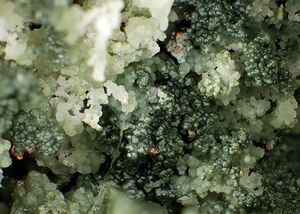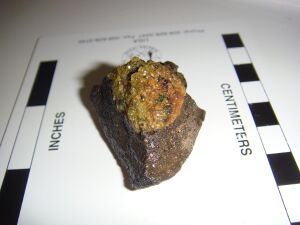Earth:Goldich dissolution series
| Discontinuous Series (Mafic minerals) | Continuous Series (Felsic minerals) | High | |||||||||||||||||||||
| Olivine | Plagioclase (Calcium rich) | ||||||||||||||||||||||
| Pyroxene | |||||||||||||||||||||||
| Amphibole | |||||||||||||||||||||||
| Biotite (Black Mica) | Plagioclase (Sodium rich) | Relative Weathering potential | |||||||||||||||||||||
| Orthoclase (K-feldspar) | |||||||||||||||||||||||
| Muscovite (White Mica) | |||||||||||||||||||||||
| Quartz (Felsic mineral) | |||||||||||||||||||||||
| Low | |||||||||||||||||||||||
The Goldich dissolution series is a way of predicting the relative stability or weathering rate of various minerals on the Earth's surface. S. S. Goldich came up with the series in 1938[1] after studying soil profiles. He found that minerals that form at higher temperatures and pressures are less stable on the surface than minerals that form at lower temperatures and pressures.[2] This pattern follows the same pattern of the Bowen's reaction series, with the minerals that are first to crystallize also the first the undergo chemical weathering.
While Goldich’s original order of mineral weathering potential was qualitative, later work by Kowalski and Rimstidt placed in the series in quantitative terms.[3] Michal Kowalski and J. Donald Rimstidt performed an analysis of mechanical and chemical grain weathering, and demonstrated that the average lifetime of chemically weathered detrital grains quantitatively fit the Goldich sequence extremely well. This helped to supplement the real-world applicability of the dissolution series.

References
- ↑ Goldich, S. S. (1938). "A Study in Rock Weathering". Journal of Geology 46: 17–58. doi:10.1086/624619. Bibcode: 1938JG.....46...17G.
- ↑ Prothero & Schwab, Donald R. & Fred (1996). Sedimentary Geology. W. H. Freeman. pp. 24. ISBN 0-7167-2726-9.
- ↑ Kowalewski, Michał; Rimstidt, J. Donald (2003-07-01). "Average Lifetime and Age Spectra of Detrital Grains: Toward a Unifying Theory of Sedimentary Particles". The Journal of Geology 111 (4): 427–439. doi:10.1086/375284. ISSN 0022-1376. https://www.journals.uchicago.edu/doi/abs/10.1086/375284.
 |


